|
|
|
H I S T O R Y O F P A K I S T A N
TAXILA
Since Sir John Marshall wrote his Guide To Taxila, it has become common to speak of the three cities of Taxila, and the visitors are taken first to Taxila Museum and then to three city sites, and finally to Buddhist establishments, anding with the story that Taxila was destroyed by the Huns in 5th century A.D
The foundation of Taxila Museum was laid by
___in ___ It is a site museum in so far as all the material exhibited here have
been excavated in the different sites of Taxila. The museum was designed in the
Greek style and galleries were set up by Sir John marshall, the diretor General
of Archaeology in British India.
In the six galleries of the museum the material
has been presented subject wise. Original objects have been exhibited in the
wall showcases and in the middle of the halls are table showcases. The present
museum building is only one-fourth of the original plan. The remaining parts are
yet to be completed.
As we enter, we come to the main big hall,
which shows in its middle a complete stupa from the Buddhist monastery of Mohra
Moradu. To its left is an archaeological map of Taxila. On its right and left
are table showcases exhibiting small finds. If we turn behind and look at the
wall show cases we see schist stone sculptures on two sides. They present scenes
from the life of the Buddha, other Buddhisattvas, and examples of Gandhara Art.
Inone corner are red sand stone sculptures, and on the other wall are two
sandstone sculptures, one of a Budhisattva and another of a Suri-god.
In the next hall to the left are stucco
sculptures from Mohra Moradan in the wall showcases. To the left is Buddhist
sculptures brought from Jaulian monastery. On the floor are are glazed tiles of
the Kushana period.
In the third hall on this side we have stucco
heads on the hall showcases. The heads show different faces and hairstyles. The
big Buddha heads are typically Gandharan in style. In the middle of the hall
area stupa within railing, some relic caskets, and a sleeping Buddha from
Bhamala monastery.
As we trace our steps back to the main hall, we
can enter a small fourth hall, which shows silver and gold jewelry and coins of
the local kings. The gold jewellery presents foreign as well as local styles.
We
can again retrace our steps to the main hall and proceed to the right to the
fifth small hall. The first important object is an Aramaic inscription of King
Piyadasi Asoka. Then
we see a
series of inscription written in Kharoshthi and also in Brahmi on paper. Then we
see small terracotta figurines and a small terra cotta ceremonial tank model. On
the opposite well we see iron objects; arrowheads, nails, horsestrips and
plough.
Finally we enter the last sixth hall, where, on the wall showcases we see silver glasses of different shapes, bowls and spoons, toilet trays, small pottery pieces, bowls and plates of terracotta and pottery arranged for distillation. On the floor are big storage jars, pestle and mortar and saddle querns.
By
Professor Dr. Ahmad Hasan Dani
GANDHARA CIVILIZATION
|
Fasting Buddha
|
|
|
This is the land which attracted Alexander the great from Macedonia in 326 B.C., with whom the influence of Greek culture came to this part of the world. During the 2nd century B.C., it was here that Buddhism was adopted as the state religion which flourished and prevailed here for over 1000 years, starting from 2nd century B.C., until 10th century A.D. During this time Taxila, Swat and Charsaddah (old Pushkalavati) became three important centres for culture, trade and learning. Hundreds of monasteries and stupas were built together with Greek and Kushan towns such as Sirkap and Sirsukh both in Taxila. It was from these centres that a unique art of sculpture originated which is known as Gandhara Art all over the world. Today the Gandhara Sculptures occupy a prominent place in the museums of England, France, Germany, USA, Japan, Korea, China, India and Afghanistan together with many private collections world over, as well as in the museums of Pakistan. Nevertheless, the zenith of this Gandhara Art is one and only "Fasting Buddha" now on display in Lahore Museum, Lahore.
The establishment of NFCH is much appreciated and a great interest is shown by the general public hence since its establishment in 1994 hundreds of proposals were received from different agencies and individuals for the conservation, preservation and publication of the Pakistan’s national heritage. It is hoped that with the continued patronage of the government, the Philanthropists and the Business Community to the NFCH we shall be able to achieve the aforesaid goal. |
|
MULTAN
In the context of the celebrations of 5000 years of Multan, beginning from November 2000 provides interesting information about this ‘city of Saints’.
Multan as a tradition which goes back to the Bronze Age. Rich in archaeology and the history, the city has a lot to offer for those in search of culture. But, more then anything, it’s the monuments that give the region a glory of its own.
Old Multan is actually a fortified city built on a huge ancient mound and with six gates set at different places. The six entrances to the old city are; Dault Gate, Bohar Gate and Lahori Gate. Three of these (Dault, Lahori and Pak) Gates have been destroyed while the remaining three are intact, although even these are actually reconstruction, from the British period. All the existing gates are of one and the same design. A circular road, locally known as the "alang" runs right around the old city, but inside the fortification wall and not outside it as in common on other old cities. However, a modern circular road also runs on the outer side of the city. The walled city is densely populated with narrow streets, winding lanes and old style houses built quite close to each other. As Multan was once a centre for wood carving, some of its old houses have good specimens of woodwork on their windows and doors.
Being a historical city, Multan is full to tombs, mosques and other monuments of Muslim origin. Apart from historical buildings, there are two other objects in the city which have almost come to be regarded as monuments on account of their excellent workmanship. These are the two huge, carved wood "Tazzia__ models", which are the best specimens of craftsmanship.
Multan, it is not surprising, is also known as "Mandinatu-Aulya", the city of saints. It has tombs, mosques and "Khanqahs" (hospices) of saints. Keeping in view their historical value, priceless art work, architecture style and craftsmanship involved, all these monuments are beautifully decorated and ornamented with blue titles, fresco-paints and mosaic work, and some with the delightful and soothing Kashi and Naqashi work for which Multan is famous.
Multan was an important city even before Islam but it gained importance after the arrival of Islam. Hence most of the crafts and monuments of artistic value are clearly influenced by Islam.
THE HISTORICAL TOMBS
The history of Multan’s Muslim architecture begins with the Muslim conquest. Little is known about the architecture of Multan prior to the 11th century, though elsewhere in Pakistan we can trace the genesis of Muslim architecture from the 8th century A.D. During the 13th and 14th century, a new style of architecture was introduced for funerary memorials of the Muslims in and around Multan the style begin with the tomb of Baha-ud-din Zakariya and culminated in the mausoleum of Shah Rukn al-Din Rukn-I- Alam, which has been admired as "one the most splendid memorial ever erected in the honour of the dead.
These two mausoleums served as perfect models for the future architecture. The architects continued to imitate them for well over six hundred years. The popularity of the style did not lessen even when the more refined and gorgeous Mughal style of Rukn-e-Alam is the beautiful tomb of Sultan Ali Akbar at Suraji Miani near Multan, which was erected in the Mughal period (992/1585).
Some of the common features of all mausolea in Multan are their tapering walls, single dome and the glazed tile decoration on the exterior. Another widespread feature is a wooden canopy, over the main grace. Decorated with carving and grills, the ceiling of the canopy is always adorned with glazed tiles of different motifs. Occasionally the grills are made of marble, ornamented with beautiful geometric designs.
THE TOMB OF SAINT BAHAUDDIN ZAKARYA
Standing at the northeastern side of the old fort which is situated on the high mound, is the tomb of Shikh-al-Kabir, Bahauddin Abu Mohammed Zakariya Al-Qurashi. The tomb occupies the centre of a vast oblong open area measuring 260 feet N.S by 203 feet E.W and is enclosed by a perimeters brick wall. It has two main gates one on the east and the other on the West Side. There is a vow of fourteen "Hujras" on the north for the "Zaireen".
The tomb was almost completely ruined during the siege of Multan in1848 AD by the British army but was repaired immediately by Makhdum Shah Mahmud. There is no original inscription on the body of the tomb to show the date of its construction and the subsequent repairs. However, from the fact that here lies the great Shaikh Bahauddin Zakariya who had erected it himself during his prime time, it can be said that it belongs to the early decades of the 13th century. The Shaikh died on the 7th of Safar (661/21 December 1262).
THE TOMB OF SHAH RUKN-E-ALAM
The mausoleum of Shah Rukn-e-Alam is also situated on the fort mound. The Shaikh was the son of Pir Sadar-Al-Din Arif born at Multan on the 9th of Friday Ramazan 649/26 November 1251. He was the grandson and successor of Shaikh Baha-Al-Din Zakariya.
Shaikh Rukn-i-Alam (Rukn-al-Din) died on the 7th of Friday (735/3 Jamadial-Awwal, January 1335). He was buried in the mausoleum of his grandfather, according to his own will. After sometime, however, his coffin was transferred to the present mausoleum. It was constructed, according to a popular belief, by Ghiyas-al-Din Tughluq (1340-1350) during the days of his governorship of Depalpur, but was given by Feruz Shah Tughluq to the descendents of Shah Rukn-I-Alam for the latter’s burial. The mausoleum of Rukn-I-Alam has been admired by not only the travelers and chroniclers but also by the art-historians and archaeologist who wrote the architectural history of the subcontinent.
The tomb was built on octagon plan, 90 ft in diameter with walls which are 414 ft high and 13.3 ft thick. The mausoleum was constructed with burnt bricks and supported by timber framing, and decorated with tile faced bricks and wood beams. The whole structure is divided into three stories. Over the second story is a smaller Octagon, leaving a narrow3 passage all around the place, above which stands a hemispherical dome. As the tomb is standing on a high artificial mound, it is visible from about 45 kilometers. Most of its patterns are geometric-created by arranging the glazed tiles-and a living testimony to creative genius of their designers. The building is also decorated with some floral as well as calligraphic patterns. In the 1970s the mausoleum was thoroughly repaired and renovated by the Auqaf Department of the Punjab Government. The entire glittering glazed interior is the result of new tiles and brickwork done by the Kashigars of Multan. This clearly demonstrates the talents and dexterity of the local craftsmen.
THE TOMB OF SHAH SABZWARI
The tomb of Shah Shamas Sabzwari is situated near the Aam Khas Bagh, about a quarter of a mile on the east of the ancient port on the high bank of the old bed of the Ravi which is now filled with a multitude of modern buildings. Shah shams Sabzwari was a celebrated "Ismaili Dai". Very little is known about Shams Sabzari’s life. According to a popular legend, he arrived in Multan at the time of Shaikh Baha-al-Din Zakariya. He breathed his last at the age of 111 years in 675/1276 and was buried in Multan.
The main features of the tomb are similar to those of the city’s other major tombs. It has a square hall in an Octagon shape topped by a high dome. There is a verandah all-round the grave-chamber, with fine arches in every side and a single entrance to the hall. In the courtyard, which is at a lower level than that of the verandah, there is small mosque. Like other decorated tombs of Multan, this tomb is also ornamented with Kaashi tile work and Naqashi work. But recently a fire damaged its entrance seriously.
THE TOMB OF SHAH YOUSUF GARDEZI
This famous tomb is situated near the Bohar Gate. Its building is quite different from the city’s other tombs, with a rectangular hall and a flat, dome-less roof. The hall, which has a small door towards the end of one of its longer sides, is constructed in a big compound. On one side of the compound stands the large hall of an imambargah. The tomb’s present building is a completely renovated one. The rectangular building is thoroughly covered with the blue Multani tiles, decorated with countless floral and geometric patterns arranged in large rectangles, square and border. The skyline is a miniature replica of a fort’s battlement and has a row of arches with borders raised in relief. Below the parapet wall runs a continuous calligraphic border on all four sides. The standard of this calligraphy, however, is not very high. Only blue and while have been used, the motifs include a rich variety of floral patterns.
THE MAUSOLEUM OF SULTAN ALI AKBAR
This tomb is situated in Suraj Miani, a locality in the northwest of the ancient city. Sultan Ali Akbar was a saint of Islamic order, and was the great grandson of Shams-Sabzwari. This is the only epigraphical evidence available about the saint on the façade of the mausoleum, however, the tomb is a very important contribution towards the adoption assimilation and spread of Multani architecture where almost every characteristic of the Rukn-I-Alam’s tomb including the octagonal plan, tapering turrets, the three storied well balanced and harmonious elevation, embellished with colourful tiles revetment, and screened window opening, his some horizontal as well oblique so also noticeable. It is because of this that the monument has been nicknamed the "Little Rukn-i-Alam". It has glazed style design used according to the available space. The mausoleum stands on a six feet high square platform.
Tomb of Hafiz Muhammad Jamal
This tomb is situated near Aamkhas Bagh surrounded with thick heavy wall of small bricks. The main square building includes a large hall, surrounding veranda and a Majlis Khana.
The tomb was built in 19th century during the reign of Ranjit Singh ( 1810). The land for the tomb was given by Sawanmal, the governor of Multan in those days. The main building was constructed under the supervision of Khawaja Khuda Bakhsh "Tami Waly" and Khawaja Muhammad Isa of Khanpur. With passage of time the building and its decoration were badly damaged, although necessary repair work was carried out on the original pattern in 1972-74. With the exception of the main entrance, the exterior of the tomb is very simple. However, the interior is profusely decorated with Kashi work and glass mosaics – Shisha MinaKari, While the tomb itself is exceptionally fine example of mosaic work. All the motifs and pattern are floral, with different colours
BALUCHISTAN
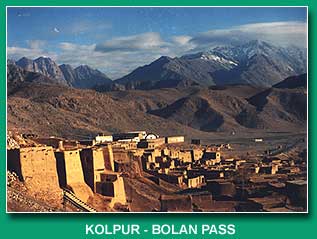 One
of the most exciting and exotic regions to explore in Pakistan is the Province
of Baluchistan.Covering an area of 347190 sq. kms. it forms the largest province
of Pakistan. It covers 44 percent of the land surface but has a population of
only 4.5 million (around 4%); making it the least populated province of the
country. About half of this population lives around Quetta, the provincial
Capital of Baluchistan.
One
of the most exciting and exotic regions to explore in Pakistan is the Province
of Baluchistan.Covering an area of 347190 sq. kms. it forms the largest province
of Pakistan. It covers 44 percent of the land surface but has a population of
only 4.5 million (around 4%); making it the least populated province of the
country. About half of this population lives around Quetta, the provincial
Capital of Baluchistan.
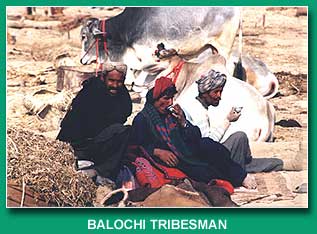 To
it’s north and west, thousands of kilometers of barren deserts and stark
mountains form the borders with Iran and Southern Afghanistan while due east, it
is divided from the rest of Pakistan by the Kirther and Sulaiman mountain
ranges. Towards the south, along the Arabian Sea, stretch 600 kilometers of
deserted sandy beaches of the Makran Coast. Most of Baluchistan lies outside the
Monsoon System of weather therefore, the climate is extremely dry. The annual
rainfall is of about 15 centimeters, and even less along the Makran Coast.
To
it’s north and west, thousands of kilometers of barren deserts and stark
mountains form the borders with Iran and Southern Afghanistan while due east, it
is divided from the rest of Pakistan by the Kirther and Sulaiman mountain
ranges. Towards the south, along the Arabian Sea, stretch 600 kilometers of
deserted sandy beaches of the Makran Coast. Most of Baluchistan lies outside the
Monsoon System of weather therefore, the climate is extremely dry. The annual
rainfall is of about 15 centimeters, and even less along the Makran Coast.
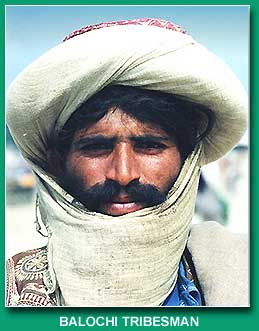 In
terms of physical geography, Baluchistan has more in common with Western Asia
than with the Sub-Continent. It’s wild & mysterious vistas of arid waste-lands,
great deserts, and formidable mountain ranges of amazing rock formations
(dramatically contoured and twisted by the earth’s violent geological movements)
make it an exotic and dramatic area to visit. It’s dry climate combined with the
natural geographical features make it one of the most daunting environments for
successful human habitation. Therefore, it is sparsely populated. Many observers
think that the region resembles the surface of the moon.
In
terms of physical geography, Baluchistan has more in common with Western Asia
than with the Sub-Continent. It’s wild & mysterious vistas of arid waste-lands,
great deserts, and formidable mountain ranges of amazing rock formations
(dramatically contoured and twisted by the earth’s violent geological movements)
make it an exotic and dramatic area to visit. It’s dry climate combined with the
natural geographical features make it one of the most daunting environments for
successful human habitation. Therefore, it is sparsely populated. Many observers
think that the region resembles the surface of the moon.
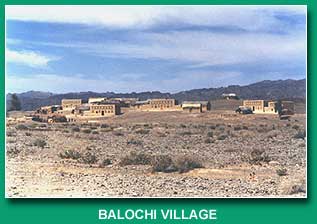 Baluchistan
is populated by a tribal society of Nomadic and semi-Nomadic tribes. The most
important are the Brahvis, Baluchis and Pathans who speak Brahvi, Baluchi and
Pushto respectively. The north east of this Province receives rain and snowfall
which support juniper forests, cultivated land and orchards, producing apples,
almonds, apricots, peaches and grapes. Most of the people in central Baluchistan
lead semi-nomadic life herding sheep, goat and camels, while others are
subsistence farmers and labourers working in Punjab and Sind during winter
months. A small portion of Baluchis also work in the Arabian-Gulf States. Some
areas of the South, near the Makran Coast, are famous for growing 300 different
varieties of dates.
Baluchistan
is populated by a tribal society of Nomadic and semi-Nomadic tribes. The most
important are the Brahvis, Baluchis and Pathans who speak Brahvi, Baluchi and
Pushto respectively. The north east of this Province receives rain and snowfall
which support juniper forests, cultivated land and orchards, producing apples,
almonds, apricots, peaches and grapes. Most of the people in central Baluchistan
lead semi-nomadic life herding sheep, goat and camels, while others are
subsistence farmers and labourers working in Punjab and Sind during winter
months. A small portion of Baluchis also work in the Arabian-Gulf States. Some
areas of the South, near the Makran Coast, are famous for growing 300 different
varieties of dates.
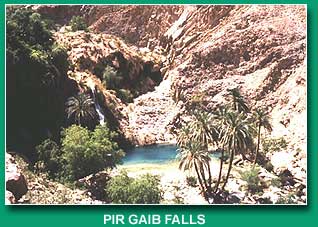 Archaeological
discoveries have confirmed that Baluchistan has been inhabited from the Stone
Age of 50,000 years ago. The important Neolithic excavation-site at “Mehargarh”
(7000-3000 B.C.) is the oldest in the Sub-Continent. Archaeologists believe that
as early as 6000 B.C., farmers in the Bolan Valley were cultivating barely and
wheat, thereby becoming probably the earliest humans to domesticate sheep and
buffalo. Recent archaeological discoveries in the Ketch and Rakshan
Archaeological
discoveries have confirmed that Baluchistan has been inhabited from the Stone
Age of 50,000 years ago. The important Neolithic excavation-site at “Mehargarh”
(7000-3000 B.C.) is the oldest in the Sub-Continent. Archaeologists believe that
as early as 6000 B.C., farmers in the Bolan Valley were cultivating barely and
wheat, thereby becoming probably the earliest humans to domesticate sheep and
buffalo. Recent archaeological discoveries in the Ketch and Rakshan
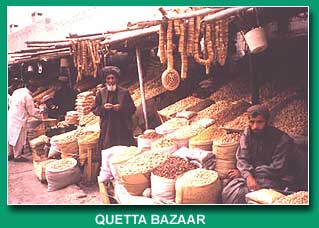 Valleys of Baluchistan have pushed the known history of this region even further
back; almost to 9000 B.C.
Valleys of Baluchistan have pushed the known history of this region even further
back; almost to 9000 B.C.
Trans-Pakistan offers various itineraries in this area both for Adventure and Cultural tours. For itineraries, prices and complete details please contact us.
MAKRAN
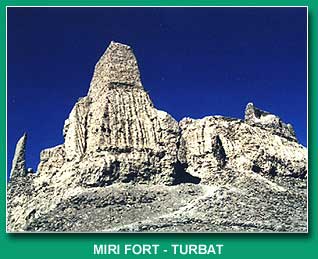 Covering
an area of 62,000 sq. kilometers, Makran forms the southern most strip of
Baluchistan, the largest but least populated province of Pakistan. Its one of
the 6 divisions of Baluchistan province having over 600 km. of coastline.
Covering
an area of 62,000 sq. kilometers, Makran forms the southern most strip of
Baluchistan, the largest but least populated province of Pakistan. Its one of
the 6 divisions of Baluchistan province having over 600 km. of coastline.
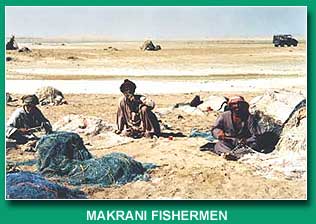 It
is hard to envisage the vast wilderness of this remote area where miles and
miles of virgin golden beaches stretch along the sea in bright sunshine and
blue skies during the winter months. As there is hardly any rain here, the few
villages and settlements depend on spring water and wells.
It
is hard to envisage the vast wilderness of this remote area where miles and
miles of virgin golden beaches stretch along the sea in bright sunshine and
blue skies during the winter months. As there is hardly any rain here, the few
villages and settlements depend on spring water and wells.
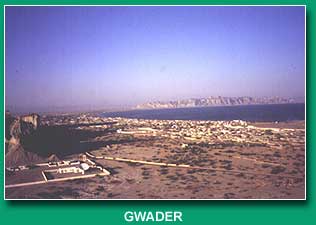 The
coast has several tiny fishing villages while main towns Gwadar, Ormara, Jiwani
and Pasni have small fishing harbours where the fisherman can be seen coming in
with their catch every morning and evening. Gwadar, Pasni, Ormara, Jiwani,
Turbat and Panjgur all have airports connecting them with Karachi and Quetta.
The
coast has several tiny fishing villages while main towns Gwadar, Ormara, Jiwani
and Pasni have small fishing harbours where the fisherman can be seen coming in
with their catch every morning and evening. Gwadar, Pasni, Ormara, Jiwani,
Turbat and Panjgur all have airports connecting them with Karachi and Quetta.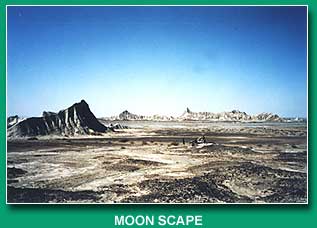
Perhaps no part of Baluchistan has figured so
largely in ancient annals as Makran. From ancient times it has held a
historically strategic position as the most direct route between the Middle East
and the riches of the Indian subcontinent.
HISTORY
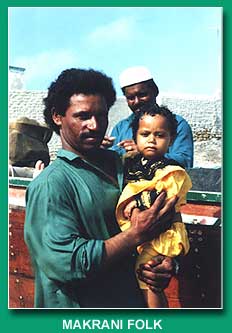 Known
to the ancients as Gedrosia, the Greeks are the first recorded visitors
to Makran. At the end of his conquests in 325BC, Alexander the Great
marched with his army through its harsh desert wastes suffering heavily due to
shortages of both food and water. Earlier, only Semiramis and Cyrus
are known to have tried to traverse Makran's wastelands with an army but with
devastating results.
Known
to the ancients as Gedrosia, the Greeks are the first recorded visitors
to Makran. At the end of his conquests in 325BC, Alexander the Great
marched with his army through its harsh desert wastes suffering heavily due to
shortages of both food and water. Earlier, only Semiramis and Cyrus
are known to have tried to traverse Makran's wastelands with an army but with
devastating results.
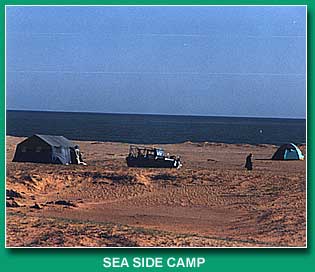 According
to the Greek historian Nearchos, Alexander did not take that route in
ignorance of its difficulties, but that he chose it on learning that no one had
yet traversed it with an army except Semiramis who escaped with only
twenty men of all her army while even Cyrus, the son of Kambyses
escaped with only seven soldiers. When Alexander heard these accounts, he
was seized with an ambition to out- rival both Cyrus and Semiramis.
According
to the Greek historian Nearchos, Alexander did not take that route in
ignorance of its difficulties, but that he chose it on learning that no one had
yet traversed it with an army except Semiramis who escaped with only
twenty men of all her army while even Cyrus, the son of Kambyses
escaped with only seven soldiers. When Alexander heard these accounts, he
was seized with an ambition to out- rival both Cyrus and Semiramis.
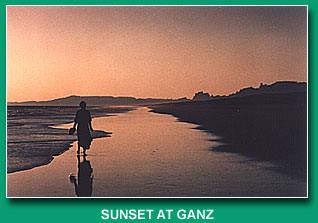 The
Greeks never really exerted more than a nominal influence over this region and
in 305 BC, Chandra Gupta defeated Alexander’s successor Seleucus
Nicator and the region came under the control of the Mauryan Empire.
Later the area fell under the Sassanian Dynasty and remained under their
control till the end of the 6th century. Rai Chach of Sind who
controlled the area for some time, followed them.
The
Greeks never really exerted more than a nominal influence over this region and
in 305 BC, Chandra Gupta defeated Alexander’s successor Seleucus
Nicator and the region came under the control of the Mauryan Empire.
Later the area fell under the Sassanian Dynasty and remained under their
control till the end of the 6th century. Rai Chach of Sind who
controlled the area for some time, followed them.
The Arabs controlled Makran from 7th
century till the 10th century. For the next 7 centuries the region
was under loose control of many foreign dynasties which followed one another in
quick succession but their power was short lived.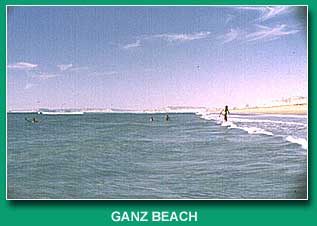
Towards the beginning of the 16th
century the Portuguese found their way to India and captured several
places along the Makran coast. They never penetrated inland and were unable to
establish anything more than heavily defended military bases at various points.
In 1581 they destroyed Gwadar and Pasni by burning them to the
ground. In the 18th century, Makran came under the control of the
State of Kalat, which was ruled by Nasir Khan I.
It was not until the 19th
century that the British got interested in this area during the time of the
First Afghan War in 1838. An expedition was sent into the area to pave way for
the building of the Indo-European telegraph line, which passed through Makran.
On its completion in 1863, Major Goldsmith was posted to Gwadar as Assistant
Political Agent. In 1872 a firm boundary between Persia and British Baluchistan
was established and Makran became a part of the British Empire. Later, after the
creation of Pakistan in 1947, it became a part of Pakistan.
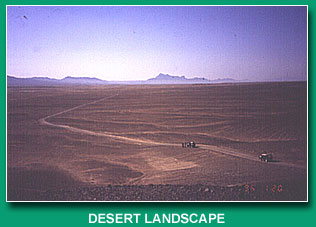 Most
areas of Makran were closed to foreigners till a short time back and at the
moment, most trips to these areas are of Exploratory nature as tourist
infrastructure there is totally missing. But, this makes it all the more
inviting for those with the Pioneering Spirit who are ready to rough it out for
the sake of blazing New Trails into un-explored territories. Trans-Pakistan is
privileged to be the first to offer Jeep-Safaris and Beach – Holiday
Adventure Trips (with possibilities of Snorkeling and Fishing)
covering most of these areas. Our team has reconnoitered the regions and has
managed to get permissions to operate exploratory trips in this area.
Most
areas of Makran were closed to foreigners till a short time back and at the
moment, most trips to these areas are of Exploratory nature as tourist
infrastructure there is totally missing. But, this makes it all the more
inviting for those with the Pioneering Spirit who are ready to rough it out for
the sake of blazing New Trails into un-explored territories. Trans-Pakistan is
privileged to be the first to offer Jeep-Safaris and Beach – Holiday
Adventure Trips (with possibilities of Snorkeling and Fishing)
covering most of these areas. Our team has reconnoitered the regions and has
managed to get permissions to operate exploratory trips in this area.
The best time for these exciting journeys is from December to March. We offer Jeep-safaris of 7 to 24 days in the central and southern Baluchistan regions. Our aims for the near future are to offer Camel-safaris and Boat-Cruises along the fabulous Makran Coast